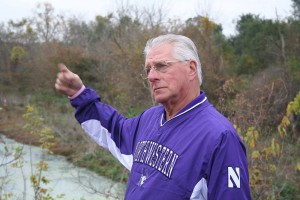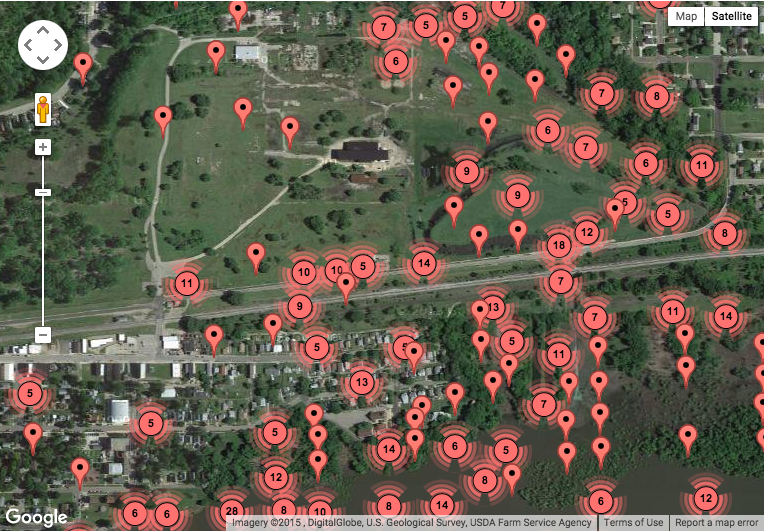By Kevin Stark
Pollution can happen in an instant – a spill, an explosion, a malfunction. But cleanup can take years, adding continuing emotional toll to the people living with toxins in the air and earth.
The toll is still growing for the community of DePue, a village of 1,800 tucked in the Illinois River Valley about 100 miles south of Chicago. The town has been fighting to remove arsenic, lead and other heavy metal toxins from neighborhoods and contaminated Lake DePue for more than 20 years.
Village leader Eric Bryant says the struggle is “frustrating and time consuming,” and “20 years is an awfully long time when you have children playing in the yards, in the ballparks, and being exposed.”
In a testament to commitment and patience, local residents continue to organize meetings, coordinate with lawyers, and just live a day-to-day life in one of the most toxic industrial waste sites in Illinois.

A longtime resident, Bryant has been village president for six years. Before he was elected, a government consultant told him that he should “get used to this area being wetland,” Bryant said.
“His mind was made up that the lake was not going to get cleaned up,” he said. “That motivated me.”
The conversation by the lake was crucial for him, and he still thinks about it today as he organizes community meetings.
Lake DePue is a prime attraction during the summers when the village hosts thousands of visitors for a national boat race. But no one swims in lake anymore, although many older residents did so decades ago.
“We grew up on the lake, swimming in the lake, boating on the lake. We fished in that area—obviously ignorant of what was going on.”
-Keith Garcia, Village of DePue
Visitors would never know from walking along the shores of the lake that the village sits on acres of toxic industrial pollution.
Keith Garcia is a science instructor at a local public school.
When he was a kid, Garcia spent a lot of time investigating the ditches and runoff sites that today are known to be toxic. “I was curious,” Garcia said. “We grew up on the lake, swimming in the lake, boating on the lake. We fished in that area—obviously ignorant of what was going on.”
For the last six years, Keith Garcia has been teaching classes and investigating the pollution of the village with students. “Instead of sitting around and saying, ‘woe is me we live in a Superfund,’ why don’t we educate the kids and get them involved in some hands on science?” he said.
One of Garcia’s students, high school junior Edgar Moreno said he likes living in DePue and that the village gets a bad rap because of its status as a Superfund site.
“Whenever you hear DePue it is something bad – like the polluted lake,” he said. “We want to be known for the good reasons. We are like a family. We all get along.”
In the center of the village is a pile of contaminated slag weighing more than 500,000 tons. It was left by a zinc smelting facility, the center of the town’s economy until it closed in 1990. New Jersey Zinc ran the smelter, but the property is now owned by CBS Corp. and the media company is responsible for cleanup. ExxonMobil is responsible for another site. In the 1970s, the energy company ran a fertilizer plant that contributed to the polluted environment.
In November, the 20-year anniversary of an agreement with the corporate interests to remediate the site came and went. But the battle for remediation and cleanup continues. Heavy metals remain in most places of the village and contaminated debris exposes residents to arsenic, lead, mercury, cyanide, and cadmium.
“It is the nature of the beast. I understand the community is frustrated with the response time, but it is not unusual.”
– Charlene Falco, Illinois Environmental Protection Agency
Lawyers that are representing the town and its roughly 1,800 people said that ExxonMobil and CBS Corp. have been delaying the effort with unnecessary studies.
An attorney representing the village, Nancy Loeb said the legal battle has become about cleanup standards. Two decades have passed and “virtually nothing has been done,” she said. “The responsible parties continue to drag out the process.”
While the slag is the most visible sign of the toxic earth beneath the village, there are four other contaminated sites around the community from the production of chemicals left behind by the industry that once fueled the town’s economy with jobs and doing business with people in town.
DePue was an industry town. The zinc smelter and a fertilizer plant anchored it. When operations ceased, many residents left. Soon real estate prices plummeted and some residents were forced to stay or absorb crushing financial losses on the sale of their homes.
Despite the exodus and toxic environment, the residents that remain in DePue continue to fight for a cleanup and a normal, everyday life.
“I am amazed by the character of this community in the face of contamination of the entire village.They continue to fight. We could not be fighting without them.”
– Nancy Loeb, Northwestern University
Bryant has been leading a community organizing effort. He ran and was elected to the town council. He commissioned a documentary about the village for a local television station, and he held screenings at a local park.
The village’s leaders and residents say the two companies that own the industrial sites—ExxonMobil and CBS Corp.—and the Illinois Environmental Protection Agency have done nothing but study and plan. DePue is a Superfund site and under federal Superfund regulations, the companies—often referred to as the “responsible parties”—must pay for the investigation and cleanup.
Company representatives said the project is governed by the federal government and it is only following the processes and detailed steps outlined by the Illinois Environmental Protection Agency.
ExxonMobil, and corporate predecessor companies, ran the fertilizer plant from the early 1970s and into the early 1980s. Representatives of ExxonMobil said the company is committed to conducting a safe investigation for the community of DePue, workers, and the environment.
In a statement, the company said it aims to have a “productive relationship in communities where we conduct business and are committed to supporting the broader needs of the community. ” The ExxonMobil foundation support a Science, Technology, Engineering and Math (STEM) program in the local school and other community and cultural programs.

A representative of CBS Corp. declined to comment for this article. In 2012, the company said that it is committed to cleaning up the contamination, according to the Chicago Tribune.
Representatives of the Illinois Environmental Protection Agency said they are reviewing one remediation plan—sequester an abandoned phosphogypsum stack—submitted by ExxonMobil and CBS Corp. Currently, the plan is scheduled to be completed in 2017, but it is unclear how long the review will take.
Phosphogypsum is a byproduct formed in the production of fertilizer.
Nancy Loeb, director of the environmental advocacy center at Northwestern University, is at the center of the pitched legal debate. She said she is continually amazed by “the character of this community in the face of contamination of the entire village.”
“They continue to fight,” she said. “We could not be fighting without them.”
Village leaders said that they hope that the public spaces and the residential properties will be remediated in 2016. But that is not likely according to statements from ExxonMobil and the Illinois Environmental Protection Agency.
For 5 years, Charlene Falco has been the project manager for environmental agency. She said the project has been “elevated to priority,” but the cleanup will take years because the geography of DePue, the seepage of contaminated metal into the lake, and the complexity of the hundreds of acres of contaminated land.
“Water migrates contamination,” she said.

It is not uncommon for a Superfund cleanup effort to take decades or longer, especially when the sites are as complicated as DePue, according to Falco. “It is the nature of the beast. I understand the community is frustrated with the response time, but it is not unusual.”
Polluted sediment was removed from a drainage ditch in 2005, but all of the neighborhoods, parks, and most of the village is still being studied by the EPA.
Members of the community remember fishing in the lake and exploring the woods in what are now contaminated sites.
Bev Harrison’s family moved to DePue from the Chicago area in 1940. Her father worked at New Jersey Zinc, and her family worked a farm. Even as her children and many young people have left the village since the zinc smelter closed in 1990, she has stayed.
“I’m active in the Church,” she said. “I live by the lake. I see the lake all the time. I like that.”
While a cleanup agreement was signed 20-years ago, the village has been struggling for a cleaner DePue for much longer than that.
“Nobody has ever enforced the agreement,” she said.


